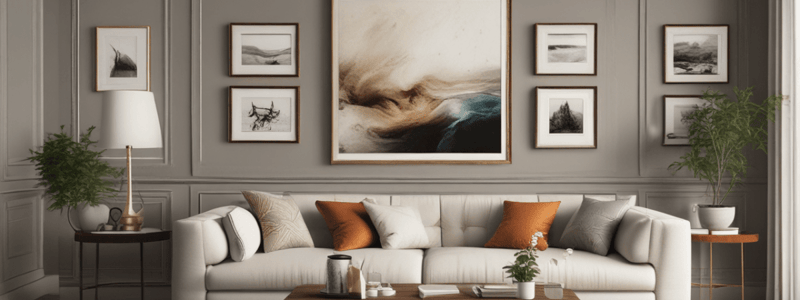Podcast
Questions and Answers
What effect do vertical lines generally have on a room's appearance?
What effect do vertical lines generally have on a room's appearance?
- Make a room feel wider
- Convey a robust impression
- Create a sense of height (correct)
- Add density to the space
Which type of line is likely to make a room feel cluttered if overused?
Which type of line is likely to make a room feel cluttered if overused?
- Curvilinear lines
- Diagonal lines (correct)
- Straight lines
- Horizontal lines
What is the primary role of form in interior design?
What is the primary role of form in interior design?
- To ensure shape coherence within a space (correct)
- To strictly adhere to traditional styles
- To add intricate details to the decor
- To create chaos and visual interest
How do curvilinear lines affect the mood of a room?
How do curvilinear lines affect the mood of a room?
What should a decorator aim for when balancing lines in a room?
What should a decorator aim for when balancing lines in a room?
Flashcards are hidden until you start studying
Study Notes
Texture
- Texture enhances visual and tactile interest, creating emotional warmth in a space.
- Uniform texture across a room can lead to a monotonous atmosphere; mixing textures introduces excitement.
- Combining textures, such as an opulent damask sofa paired with various cushions, balances luxury and comfort.
- A diverse texture palette adds depth and engages the senses; a design board can help visualize these combinations.
Patterns
- Diverse patterns bring character and whimsy to interior design.
- Geometric patterns create a modern vibe; checks lend a cozy atmosphere; tapestries add elegance.
- Light patterns influence mood and relaxation, while stripes are versatile for formal or casual settings.
- Mixing patterns like stripes, plaids, checks, and florals can enhance visual intrigue; a unifying color aids cohesion.
- Traditional patterns (plaid, stripes, florals) are timeless, whereas trendy patterns (leopard print, tropical motifs) add a contemporary touch.
- Combining solid color anchors with patterns creates harmonious balance.
- Using a design board to pre-plan ensures a cohesive and well-thought-out decorating scheme.
Scale
- Scale relates to the size of items in a room relative to each other and the space.
- Large objects may seem smaller in spacious areas; smaller items appear larger in confined spaces.
- Proper scale assessment prevents overwhelming small spaces and ensures items do not feel insignificant in large areas.
- Consideration of scale includes the relationship of furniture with room occupants, promoting comfort and practicality.
- Consistency in scale fosters balance; for example, pairing a small chair with a large piece can disrupt harmony.
- Large artwork serves as a focal point, while smaller pieces may be lost on vast walls.
Line
- Lines can be vertical, horizontal, or diagonal, influencing the perception of space.
- Vertical lines offer a sense of height; horizontal lines create width; diagonal lines introduce dynamism.
- All room elements contain lines, from flooring patterns to furniture edges, guiding the viewer's eye.
- Curvilinear lines provide softness; straight lines convey strength, both crucial for setting a room's mood.
- Balance is key; too many lines can create visual clutter, while too few render a space dull.
- Thoughtful placement of lines leads to transformative and harmonious designs, enhancing visual appeal.
Form
- Form pertains to the shape of objects and architectural elements, integral for cohesion in interior design.
- Selecting items that complement the room's form creates unity; angular furniture in minimalist styles aligns with contemporary forms.
- Cohesiveness in form is essential for establishing a visually pleasing environment that resonates with the overall design theme.
Studying That Suits You
Use AI to generate personalized quizzes and flashcards to suit your learning preferences.





